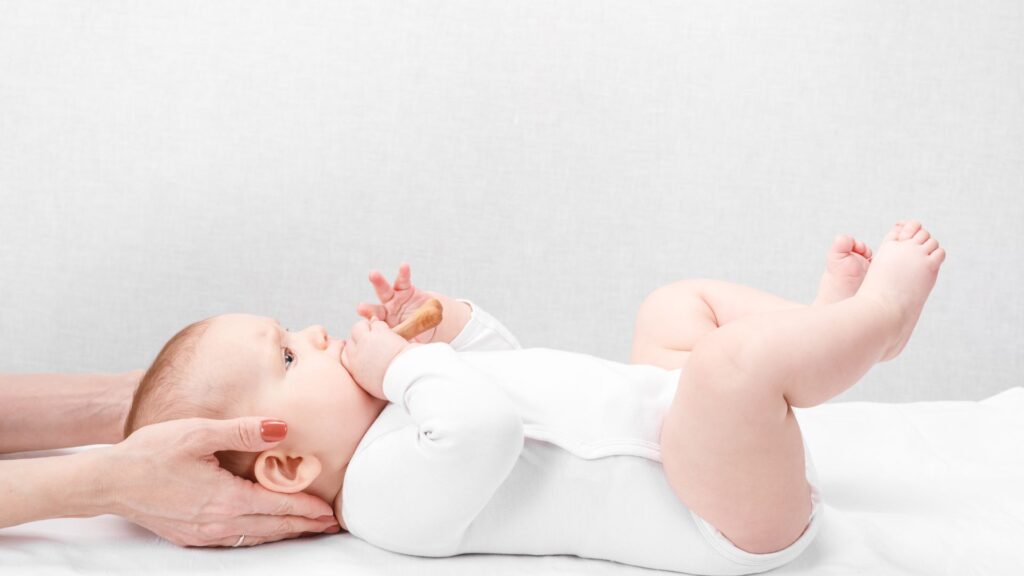You might feel worried if you notice your baby’s head looks a bit flat. Please remember, you are not alone—about 30% of babies at three months show signs of flat head syndrome, but this drops to just 7% by their first birthday.
Most mild cases improve on their own as your baby grows and moves more. If you are wondering how to prevent flat head syndrome naturally, simple changes at home can make a big difference. Don’t blame yourself; many factors are outside your control.
How to Prevent Flat Head Syndrome Naturally
If you want to know how to prevent flat head syndrome naturally, you can start with a few simple habits at home.
Early prevention is key, especially before your baby turns 14 months, as the skull bones harden after this age. Let’s look at the most effective and natural ways you can help your baby develop a healthy head shape.
Tummy Time
Tummy time is one of the best answers to how to prevent flat head syndrome naturally. When you place your baby on their tummy while they are awake and supervised, you help them build strong neck and shoulder muscles. This position also takes pressure off the back of their head, which is important for shaping the skull.
- Tip: Start tummy time from day one. Even a few minutes at a time makes a difference.
Here’s a handy table to guide you on how much tummy time your baby needs as they grow:
| Age Group | Recommended Daily Tummy Time Duration | Notes on Progression and Purpose |
| Newborn (Day 1) | Start with a few seconds to minutes | Gradually increase daily to build comfort and muscle strength |
| By 2 months | 15 30 minutes total, divided sessions | Build endurance and strength gradually |
| By 3 months | About 30 minutes total daily | Can be split into multiple sessions; important for preventing flat head syndrome |
| 4 6 months | 30 60 minutes total daily | Encourage exploration and interaction |
| 6 months+ | 10 15 minutes, 5+ times a day | Support rolling and sitting development |
You might notice your baby fusses at first, but keep going. Break tummy time into short, frequent sessions. Place toys or get down on the floor to make it fun.
Studies show that babies who get regular tummy time have a lower risk of developing flat spots. The phrase “Back to Sleep, Tummy to Play” sums it up well—always put your baby on their back to sleep, but give them plenty of tummy time when awake.
Varying Head Position
Another important step in how to prevent flat head syndrome naturally is to change your baby’s head position often.
Babies have soft skulls, and if they rest their head in the same spot every time, a flat area can develop. You can help by gently turning your baby’s head to the left or right when you lay them down to sleep.
Try alternating the end of the cot where you place your baby’s head each night. This encourages your baby to look in different directions and spreads out the pressure on their skull.
Note: Always place your baby on their back to sleep, but vary the direction they face.
You can also use feeding time to your advantage. If you bottle feed, switch arms for each feed. If you breastfeed, alternate sides.
This not only helps with bonding but also encourages your baby to turn their head both ways. Using a nursing pillow can make this easier and more comfortable for both of you.
Limiting Time in Baby Gear
Many parents wonder how to prevent flat head syndrome naturally when modern life involves so much baby gear. Car seats, bouncers, and swings are helpful, but too much time in these devices can increase the risk of flat spots. These seats keep your baby’s head in one position, putting constant pressure on the same area.
Here are some simple ways to reduce this risk:
- Use car seats only for travel, not for naps or playtime.
- Limit time in bouncers, swings, and prams.
- Hold your baby upright or use a baby carrier when possible.
- Give your baby plenty of time on the floor for play and movement.
Tip: Carrying your baby in your arms or a sling gives their head a break from pressure and helps with bonding.
If you follow these steps, you will see how to prevent flat head syndrome naturally without needing special equipment. The key is to keep your baby moving and change their position often.
Early action, especially in the first four months, makes the biggest difference. If you have any concerns, speak to your health visitor or GP—they can offer advice and support.
Position Changes
Changing your baby’s position during the day helps their head grow evenly. You can add these small changes to your daily routine. It does not take much effort.
Alternating Cot Position
Babies like to turn towards light or your voice. If you put your baby in the cot the same way each time, they may rest on one spot every night.
You can help by changing which way your baby faces in the cot each time. For one nap, put their head at one end.
For the next nap, put their head at the other end. This helps your baby look both ways. It spreads out the pressure on their skull.
- Always put your baby on their back to sleep for safety.
- Change which end of the cot your baby’s head faces.
- Place toys or mobiles on different sides to help your baby turn their head.
Experts say this simple change lowers pressure on one part of the head. It helps stop flat spots from forming. Studies show that changing head position during sleep is safe and works well for a healthy head shape.
Switching Sides During Feeds
Your baby may like turning their head to one side when feeding. If you switch arms or sides often, your baby uses both sides of their neck. This stops them from always turning one way. This habit is good if you want to stop flat head syndrome naturally.
- Change arms or breasts with each feed.
- Hold your baby in new ways to help head movement.
- Carry your baby on different sides during the day.
Changing sides during feeds helps your baby’s neck muscles get strong. It also stops pressure from building up on one spot. Breastfeeding often means you switch sides, but bottle feeding parents can do this too.
Using Nursing Pillows
Nursing pillows make feeding more comfortable for you and your baby. They also help you change your baby’s position easily. With a nursing pillow, you can support your baby so they turn their head different ways. This lowers the risk of flat spots and helps the head grow evenly.
Research shows that using things like nursing pillows helps babies move their heads more. It lowers pressure on one side. Nurses and doctors suggest these pillows, especially for premature babies. They help babies grow well and stop head flattening.
Try putting a colourful toy or mobile on different sides during feeds. This will catch your baby’s eye and help them turn their head.
Making these small changes each day can really help your baby’s head shape. If you keep doing these things, you will see how to stop flat head syndrome naturally. You will also help your baby grow well.
Encourage Head Movement
Play and Toys
You can help your baby move their head more by making playtime fun and engaging. Babies love to look at new things.
If you place colourful toys around the cot or playmat, your baby will turn their head to see them. This simple trick spreads out the pressure on their skull and helps their neck muscles grow stronger.
- Place soft toys or rattles on different sides of your baby during play.
- Use a play gym with hanging toys to encourage reaching and rolling.
- Try crinkle books or teethers to catch your baby’s attention.
- Move toys slowly from side to side so your baby follows them with their eyes and head.
Babies enjoy tummy time more when you join in. Get down on the floor, make silly faces, or sing songs. Your baby will want to lift their head and look at you.
You can also use tummy time as a chance to play. Put your baby on their tummy on a soft mat and place toys just out of reach.
This encourages them to lift their head and move towards the toy. If you want to know how to prevent flat head syndrome naturally, these playful moments make a big difference.
Interactive Activities
Interactive activities keep your baby interested and help them practise moving their head. You can try simple games every day.
For example, place your baby tummy down on a cushion facing you. Talk, sing, or make funny faces. Your baby will turn their head to watch you.
- Sing songs with actions, like “Head, Shoulders, Knees, and Toes”, and gently help your baby move their arms.
- Encourage your baby to explore their hands and feet by clapping or tickling.
- Use tracking games by moving a bright object slowly across your baby’s view. Watch as they follow it with their eyes and head.
- Give your baby time on a playmat to reach, roll, and grab toys.
Pediatricians recommend activities like pull to sit exercises. Gently hold your baby’s hands and help them sit up from lying down. This builds neck strength and head control.
Always praise your baby and stop if they seem tired. These small, daily activities support healthy development and show you how to prevent flat head syndrome naturally while having fun together.
Reduce Pressure on the Head
Babywearing and Carriers
You might find that carrying your baby in a sling or soft carrier feels natural and keeps your hands free. Babywearing does more than just help you get things done—it also helps protect your baby’s head shape.
When you carry your baby upright against your chest, you take the pressure off the back of their head. This is a simple way to lower the risk of flat head syndrome.
Here’s why babywearing is a great choice:
- Babywearing reduces the time your baby spends lying on their back in car seats or prams, which can cause flat spots.
- Carrying your baby upright lets their head move freely, so pressure does not build up in one place.
- Inward facing babywearing supports your baby’s neck muscles and helps them learn to turn their head.
- Using a sling or carrier also supports healthy hip development, which many baby seats do not.
Tip: Choose a soft, inward facing carrier for the best support. Always check your baby’s face is visible and their chin is off their chest.
You can use babywearing for walks, chores, or just cuddles. It keeps your baby close and gives their head a break from hard surfaces.
Switching Supports
Changing how and where you support your baby’s head each day makes a big difference. Babies need variety to help their skulls grow evenly. Try these easy swaps:
- Change your baby’s head position several times a day.
- Limit time in car seats, swings, and bouncers.
- Alternate which end of the cot your baby sleeps at each night.
- Move toys and mobiles to different sides to encourage head turning.
- Carry your baby on different shoulders or hips to help them look both ways.
- Give your baby plenty of supervised tummy time to build neck strength.
Early habits matter most. The first few months are when your baby’s skull grows fastest, so small changes now have a big impact.
You do not need fancy equipment. Just keep switching things up and watch your baby explore new views. These simple steps help prevent flat spots and support healthy development.
Special Pillows and Helmets
When to Use Special Pillows
You might see special pillows in shops or online that claim to prevent or treat flat head syndrome. These products look soft and gentle, but they are not safe for your baby.
The FDA and doctors warn against using head shaping pillows for infants. These pillows have not shown any real benefit for preventing or treating flat spots. In fact, they can be dangerous.
Important: Special pillows can increase the risk of suffocation and sudden unexpected infant death (SUID). Babies should always sleep on a firm, flat surface with no pillows, blankets, or soft toys.
Here’s what you need to know:
- Head shaping pillows are not approved medical devices.
- They can delay proper diagnosis and treatment of more serious conditions.
- Experts recommend safe sleep practices—no pillows, no loose bedding, and no toys in the cot for the first year.
If you worry about your baby’s head shape, speak to your health visitor or GP. Avoid using any special pillows, even if they seem popular.
Helmet Therapy
Sometimes, babies with moderate or severe flat head syndrome need extra help. If simple changes and tummy time do not work, your doctor might talk to you about helmet therapy. Helmets are custom made devices that gently guide your baby’s head into a rounder shape.
- Doctors usually suggest helmet therapy for babies aged 3 to 18 months who have not improved with other treatments.
- Starting helmet therapy before 6 months often leads to better results and a shorter treatment time.
- Studies show that helmet therapy can improve head shape and facial symmetry, especially when started early.
A large review found that after helmet therapy, the number of babies with good facial symmetry rose from 13.7% to 66.7%. Most babies tolerate helmets well, but some may have mild side effects like skin irritation.
Always follow your doctor’s advice and ask questions if you have concerns about helmet therapy.
Most Babies Don’t Need These
You might feel worried if you see a flat spot on your baby’s head. Most of the time, you do not need special pillows or helmets. Flat head syndrome often gets better on its own as your baby grows, moves more, and spends less time lying on their back.
- Simple steps like tummy time, changing positions, and limiting time in baby gear work for most babies.
- Helmets are only for moderate to severe cases that do not improve with these natural methods.
- Special pillows are not safe and should not be used.
Remember, you are doing your best. If you have any doubts, your health visitor or GP can help you decide what is right for your baby.
When to Seek Medical Advice
Warning Signs
You might not know when to ask your doctor about your baby’s head shape. Most flat spots get better with simple changes at home. But some signs mean you should get medical help.
Watch for these warning signs:
- Flattening on one side at the back of the head
- One ear sits further forward than the other
- Head tilts to one side or forehead sticks out
- Odd bumps or ridges along the skull
- The soft spot looks missing, full, or bulging
- Blood vessels on the scalp look very noticeable
- Feeding is poor or vomiting is strong
- Seizures or strange movements happen
- Severe unevenness that does not improve with position changes
- Head size grows slowly or stops growing
- Face looks uneven or not balanced
- Delays in development or trouble moving the neck (like torticollis)
If you see any of these signs, or if you worry about your baby’s head shape, see your GP or health visitor. Early checks can rule out serious problems and help your baby get the best care.
What to Expect
When you visit your healthcare provider, they will be kind and helpful. You can talk about your worries about your baby’s head shape. The doctor or nurse will listen and use special tools to measure your baby’s head.
They will check for serious conditions, like craniosynostosis, which needs different care. Most times, they will suggest gentle changes at home. This might include more tummy time or holding your baby in new ways. Sometimes, they may suggest physical therapy if your baby cannot turn their head well.
If your baby’s flat spot is moderate or severe, or does not get better, helmet therapy may be discussed. Your provider will explain everything and answer your questions. You might have more visits to check your baby’s progress and get more help.
Remember, you are not alone. Your healthcare team wants you to feel sure and supported at every step.
You can help your baby avoid flat head syndrome in simple ways. Give your baby lots of tummy time every day. Change your baby’s position often during play and sleep.
Try not to keep your baby in car seats or swings for too long. Taking action early really helps your baby’s head shape. Research shows these steps support healthy growth and development. If you are ever unsure, ask your health visitor for advice. You can also talk to groups like CAPPS for support.
Most babies get better with these easy changes. You are doing well—believe in yourself and enjoy time with your baby.
FAQ
What is the best age to start tummy time?
You can start tummy time from birth. Begin with a few minutes each day. Increase the time as your baby gets stronger. Early tummy time helps your baby’s head shape and builds neck muscles.
Can my baby sleep on their side to prevent flat head?
No, always place your baby on their back to sleep. Side sleeping is not safe and can increase the risk of SIDS. Use tummy time and position changes when your baby is awake.
How long does it take for a flat spot to improve?
Most flat spots improve within a few months. You will see changes as your baby grows and moves more. Keep using tummy time and changing positions every day.
Do I need to buy a special pillow for my baby?
You do not need a special pillow. Experts say pillows are not safe for babies. Stick to a firm, flat mattress with no loose bedding. This keeps your baby safe and supports healthy head growth.



